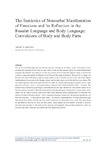The Semiotics of nonverbal manifestation of emotions and its reflection in the Russian language and body language: convulsions of body and body parts

Ver/
Use este enlace para citar
http://hdl.handle.net/2183/13410Coleccións
Metadatos
Mostrar o rexistro completo do ítemTítulo
The Semiotics of nonverbal manifestation of emotions and its reflection in the Russian language and body language: convulsions of body and body partsAutor(es)
Data
2012Cita bibliográfica
Culture of communication / Communication of culture, 2012: 125-132. ISBN: 978-84-9749-522-6
Resumo
[Abstract] One of the problems linguists and semioticians are working on nowadays is the description of how emotions are conceptualized in the two sign codes: in the natural language and in the corresponding body language. But scholars have analyzed usually only limited sets of emotional corporeal signs, whereas other numerous signs and models of behavior are still beyond the scope of research. The goal of my paper is to describe one class of Russian emotional signs, which, as far as I know, has never been described. Bodily manifestations of emotions in the Russian culture and semiotic codes can be divided into two classes. The first class is gestures, which are understood here broadly. It includes manual gestures, gestures of the head, shoulders and legs; mimics, meaningful glances, postures and verbal-nonverbal forms – manners. The second class is formed by physiological reactions that are not signs themselves. The specific feature of the Russian semiotic systems is that emotional gestures and physiological reactions have a great many verbal names that are used in various collocations and idioms denoting bodily manifestations of emotions. The special subclass of Russian idioms – that of gestural phrasemes connected with gestures semantically or/ and etymologically – is discussed in more detail. The semiotic representation of Russian emotional signs that denote convulsions of body and body parts constitutes the main part of my work. The convulsions are spontaneous motions of body and body parts, which appear as uncontrolled reactions to physical and emotional impulses. I will point out the semantic and pragmatic features that contrast the words and gestures, and show corporeal sign symbolism that stands behind them.
ISBN
978-84-9749-522-6





